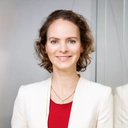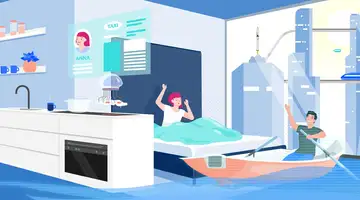
Anna's Dream
Imagine the year 2084. Technology and products that sound like science fiction today could be our reality. Tech companies like SCHOTT are already laying the groundwork for the future. The story may take place exactly like this in the future – except for its parts that are entirely fictional.
Anna lies in bed sleeping. The big wave hits her unexpectedly. As droplets of water roll down her face, she wakes up. She takes a deep breath. She can taste the salt on her tongue. The sound of the surf fills the air. Wind whispers in her ear. Anna looks around. She is alone on the high seas, one wave after another breaking over her bed. She rubs her eyes and spots a small rowboat approaching in the distance. As her automatic climate-control system fills the air with drops of brine, Anna reaches for her contact lenses made of ultra-thin glass with an augmented reality function. Slowly, she realizes who might be behind this unusual wake-up call.
"That's a charming way to say good morning. You just can't leave it alone," Anna exclaims.
"Good morning, honey," says Robert, who has appeared as a hologram in his rowboat, which is rocking in the water beside her at the edge of the bed. "I just had to try out the new 4D ambient wake-up program Magic Mare 2.0. Did I scare you?"
"No, not really, I was still too sleepy for that. But that was pretty cool. You always think of something new," Anna says. "Wait a minute. Activate beach mode!"
Anna uses voice control to switch from Robert's ocean program to a beach setting in her bedroom. Now the sun is shining and the wind is gone. In the background, there is a pleasant murmur of waves and some seagulls. On the bed, her partner Robert sits next to her as a hologram. This special spatial experience is made possible by multifunctional exterior walls made of glass, which are controlled by artificial intelligence. They are flexibly transparent and can be used to simulate photorealistic environments. It's a feature that all interactive living units in this large block of buildings in the city center have. Robert knows the access codes and has logged onto the system. He is an aerospace engineer who maintains the communications and power equipment at the Orbital Reef commercial space station. Built nearly 38 million kilometers from Earth in 2051, it is a popular stopover for tourists on their vacation trips to Mars.
It's Saturday, May 24, 2084, and Anna doesn't have work today. But the ambient program has given her an idea.
"I think I'll go to the beach again today," she says.
"You do that, I'd love to be there, but I still have to finish my project," Robert points out.
"How's it going?"
"Great, the space station's new solar panels are working extremely reliably. They've already survived their first dust storm, too. The photovoltaic system's ultra-thin protective glass is truly a miracle against radiation."
Anna had to smile. Robert is passionate about science and the latest innovations that make life easier and broaden horizons. The protective glass is not only virtually indestructible, but also self-cleaning thanks to its nanostructures, which make it virtually maintenance-free. Robert explains that his last colleague switched to the new OXIma2100 breathing support. Oxygen masks are now obsolete in space, since oxygen can be generated from carbon dioxide in real time practically anywhere. The foundation for this was laid more than 50 years earlier with the Mars Oxygen ISRU Experiment, or MOXIE for short. As part of the Mars 2020 rover mission, pure oxygen was extracted from the Martian atmosphere for the first time by the electrolysis of carbon dioxide. This was made possible by temperature-resistant sealing glass. It ensures that the required electrolysis cell functions perfectly even under the extreme conditions of space. And it does so with the help of a miniscule electrolysis device placed intramuscularly in the chest cavity, which can be permanently housed in the body thanks to a hermetic microelectronic packaging made of a glass-metal compound.
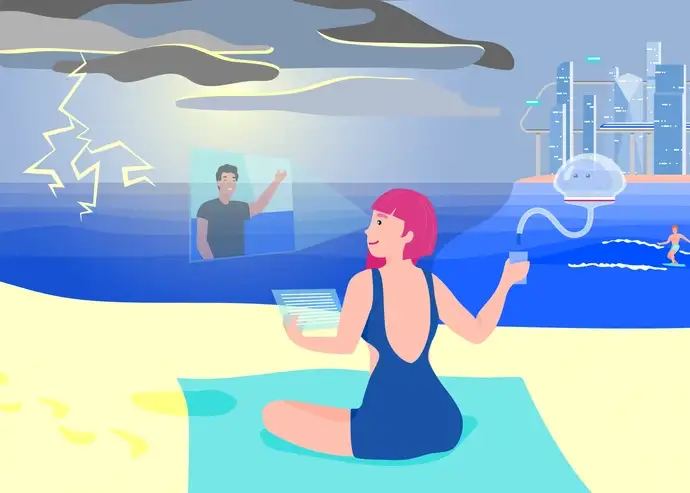
A relaxed morning
"I have to get on with my work now," Robert says.
"Then I wish you the best of luck. Will you be home Sunday night?"
Robert nods, "I’ve already got a ticket on the hyperspace shuttle. Have fun at the beach."
"Thanks. Good luck then. See you," Anna says and deactivates the hologram connection with two quick blinks of an eye.
Anna walks into the bathroom. On the way there, she assembles her breakfast with the help of her AR contact lenses. A push message in the mirror indicates that scientists have developed a smart medicine to treat wounds. It not only treats injuries within minutes but also transmits information directly to one’s family doctor via the molecules it contains in the event of complications during wound healing. Using eye control, she navigates through the latest news, orders an air cab for her outing, and sends messages to friends and acquaintances via voice and gesture control.
The smell of coffee and a freshly fried algae omelet wafts into the bathroom. Anna goes into the kitchen. Simon is already waiting for her. Simon is a small, flying robot. A kind of constant companion for everyday life. A multilink robot, he has the ability to transform air. This means that his modular device can change shape in the blink of an eye, and can transform, for example, from a square helicopter into a thin snake, enabling him to enter tight spaces for repairs or to take on completely different shapes as necessary. Simon’s main components are made of ultra-thin glass, which can be flexibly bent and are practically unbreakable. And Simon is a tireless performer. With the latest software update, his battery lasts an outstanding twelve months without recharging thanks to a new solid-state ion conductor.
While Anna was still in the bathroom, Simon was already preparing her breakfast selection on her glass-ceramic cooktop. The cooktop is controlled contactlessly by Simon using electrical pulses. The design adapts to the selected ambient program. Anna has settled on having her breakfast in a green meadow today. She quickly chops up some chives to garnish her omelet... "Ouch," a small slip and that was her finger. While she stops the bleeding using a kitchen towel, she orders the new medication for wound treatment via eye control with her AR contact lenses. She sits down at the table.
"Does the omelet taste good?" asks Simon.
"Perfect, as always, thank you. Especially the chives...." Anna slightly grimaces. "Are there any more updates from my community that I need to know for today?"
Simon flies straight to Anna and flashes green. "No, no highly relevant entries. Your friend Sarah is on vacation again. This time on Astra62. She sent you a sunset. Do you want me to play the timelapse?"
"No, I know that's where the sky turns green," Anna replies.
"Oh, yes, your medicine and air cab are here."
Before Anna leaves the apartment, Simon administers the requested dose of medication. It was delivered in a small vial made of durable borosilicate glass by hyper-taxi just-in-time via the in-house dropbox with which each apartment is equipped. And this is despite the fact that the drug was developed and approved only a few hours ago. This is made possible by the glass vials that are functionally coated so that chemical adjustments to the drug's blueprint can be made in seconds during transport. Anna grabs her bathing suit and Simon directs the air cab to the induction charging station made of glass-ceramics on the 82nd floor. Anna and Simon climb aboard. She likes these rides because they are absolutely relaxing. In their personal seating capsule, sidelights and ambient lighting simulate a convertible ride through a green landscape.
Anna covers the last few meters to the beach on foot while Simon hovers next to her at eye level. She loves it when the sand tickles between her toes. In the distance, she spots a surfer hoping for the perfect wave. She unrolls her glass reading tablet and begins to browse. Anna likes historical books. Today, she's eager to keep reading Women's Business. It's the biography of Emma Walsh, who was elected the third female U.S. president in 2061. But Anna doesn't get that far. A gust of wind unexpectedly blows sand in her face. She looks up and is startled. Practically out of nowhere, a dark storm front has appeared. Where did it come from? A twitching flash of lightning interrupts her thoughts. The bright light briefly robs Anna of her vision. This is followed by a deafening crack of thunder. Is that Robert again? Anna instinctively turns her head to the side. She puts her hands in front of her face to protect herself. But fortunately the wind dies down quickly. After a few seconds, she can see clearly again. Anna looks around for orientation on the beach. In the distance, the surfer is still falling regularly into the water. Meanwhile, the sky is almost cloudless. As abruptly as the weather phenomenon has come, it has disappeared just as quickly. Anna breathes a sigh of relief as her pulse slowly returns to normal. Where is Simon?
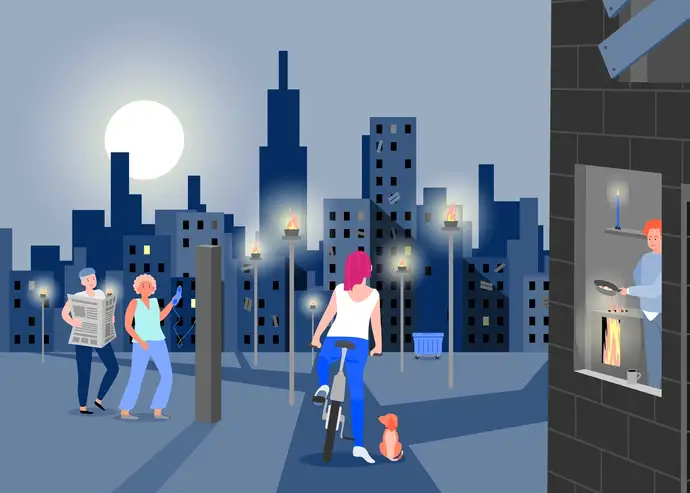
A dystopian vision
Anna tries to establish a communication link with Robert via the AR contact lenses. Nothing happens. Anna wants to rub her eyes. But she can't. What is that? She gets a fright. Somehow, her vision is not 100% sharp. Where are her AR contact lenses? Anna turns around. There's a paperback book in the sand. It's Emma Walsh's biography, which she was reading earlier on the tablet. A dog suddenly barks beside her and jumps up excitedly on her legs. As she is about to send him away, she finds a badge around his neck. Simon is written on it.
Anna jumps up in irritation. She looks up. The sun is burning. Maybe it's just too hot today? She packs her things and leaves the beach. Simon runs after her. There, where the boarding gate for the air cab used to be, leans a bicycle with a chain-drive. Anna's pulse races. Panic sets in. In desperation, she grabs the bike, puts the dog in the small transport rack on the handlebars and pedals off. She just wants to get out of there fast. After a few meters, the city appears in the distance. Anna brakes abruptly. Stunned, she looks at what's in front of her eyes and can't believe it. Unadorned steel and concrete towers dominate the skyline, all dreary monoliths either completely windowless or with inlets, some of which are sealed up with wooden boards. Anna feels as if she is trapped in a nightmare, a dystopian future scenario. She is close to tears. She pedals, faster and faster. Maybe everything will be okay back at home. Her heart races. Not a single car is on the road, not to mention flying objects. She passes a column. People are lining up. There is a telephone with a dial on it. After several hours, she finally gets home but nothing is the same. Everything is strange. Anna stands in front of a gray concrete cube. The address is correct but no one can possibly live here, she thinks to herself.
In the rattling steel elevator, Anna manages to push the rusty buttons with difficulty. She can hardly wait until she arrives on the 82nd floor. She enters her apartment, closes the door behind her, and hopes that all is well now. But none of her voice commands work. There are no lights and no display in the entire apartment. In the kitchen, there is an aging stove with electric steel hotplates. The wind whistles through the apartment. In every room there are large holes in the walls without windows. In the bathroom, there is only a plastic bathtub. For once, Anna is glad there is no reflection of her in the mirror. She feels dizzy. She closes her eyes for what feels like an eternity – and seems to lose her balance.
After a few minutes, when she has regained some order in her thoughts, she wipes the sweat from her forehead. Anna opens her eyes. She is sitting on the beach. There is a slight breeze. Her gaze becomes clearer. She looks into the distance. The surfer is now catching the perfect wave. Carefully, she activates the AR contact lists and connects to Robert. It works. Anna is relieved. Robert's hologram hovers over the sand.
"Hi, honey, what's so urgent?", Robert wants to know.
"You won't believe what I just experienced."
"What's wrong? You look absolutely terrified. First calm down a bit," Robert says.
"That was a total nightmare. I was trapped in a world without glass. A world like in a horror movie. Terrible," Anna tells him, "I must have fallen asleep. I was dreaming it all. But it seemed so real."
"A world without glass?" says Robert. "Unthinkable!"
They both laugh. Suddenly, Anna spots a dark cloud on the horizon.
"I'm sorry, we have to call it a day," Anna says. "I have to go home right away."
For years, SCHOTT research teams have been making great strides towards unbreakable glass. Learn how they are succeeding in making glass even stronger and more robust, enabling devices such as Anna's glass tablet in the future.
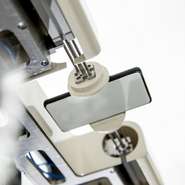
On the edge of augmented reality
Innovators are laying the groundwork for Anna's contact lenses as early as 2022. Learn more about how the industry is fine-tuning the future and the role glass plays.
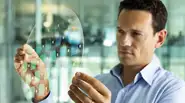
Borosilicate glass is expected to remain the gold standard for storing medicines in 2084. Read how researchers are already ensuring that the glass type will remain viable in the future.
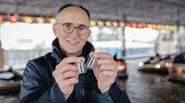
Through new formulations, researchers are succeeding in developing ever different properties from materials. Find out how they approach the creation of these recipes today and what options are still open to them for the future.

With the help of material informatics and artificial intelligence, SCHOTT's research teams want to push the technological boundaries of glass even further. Executive Vice President for R&D Dr. Matthias Müller reveals how they are doing this.

For a more digitized future, we need new ways to generate energy. Bill James, the Head of Research & Development North America, provides insight into how laser glass can help.
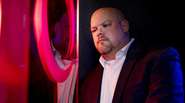
Pushing the limits of possibility
If it is not man himself who pushes the limits of what is possible, then it is research and material development. One material that goes to the extremes is ultra-thin, flexible glass. Read how it is produced.

